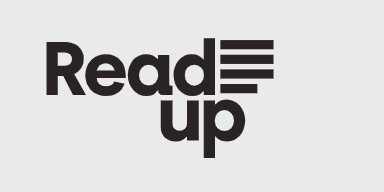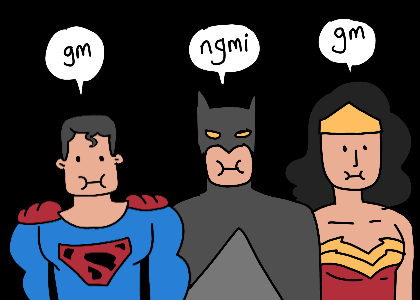Exploring Ethereum's ERC-721 Standard
Because NFTs are about way more than digital art
PSA: I’m now experimenting with ads at the top of my newsletter. Since this newsletter is not sponsored by anyone (for now), I’m going out of my way to shout out my favorite brands and experiences.
Have you heard about Readup? It’s a social media app where your attention is the currency with which you interact. You know how you’re bombarded by so much information daily and now it’s affected your attention span? I was like that a few years ago, when I found Readup. Its powerful algorithm tracks what you’re reading, and how much of it you’re actually reading (the company used to be called Reallyread.it, so, you know, they’ve been about that life).
Readup is an app and a community that:
Encourages you to thoughtfully read an article before commenting on it (you can’t join discussions until you’ve read at least 90% of the article)
Helps you connect with a community of readers and reclaim your fragmented attention span.
(If you pay for a subscription) automatically splits a percentage of your monthly subscription and shares it with the writers whose writing you enjoyed that month!)
The Information Superhighway moves at breakneck speed. Readup is the gas station for the weary traveler.
Let us begin.
Gm.
Since writing An African Skeptic’s Guide to NFTs, I’ve found myself musing on certain philosophical questions. At the risk of ending up as a footnote to Plato, I’ve been asking myself ‘what does it mean to create a thing?’, and ‘what does it mean to own that thing?’
What is ownership? And how do we define value? What does it mean when the guiding philosophy of software (as a non-rivalrous good, which means that more people using software does not mean less software for others) is basically upended by NFTs: taking one of the most infinitely reproducible things on earth (digital art) and artificially making it rare so that we can slap a price tag on it and shoot the rates through the roof?
This has kept me up for a while. I’ve read insightful threads and articles from biting critics of NFTs as well as arguments from (what I consider to be) well-reasoned evangelists of NFTs, and I find that a lot of it involves kicking the can further down the road:
We acknowledge that digital art isn’t in itself rare, so we create artificial rarity by embedding rarity via randomness in the algorithm that creates the (commoditized) 10,000 PFP NFTs that we see strewn on the open sea (*cough* I now Intend all puns)
We get upset at people stealing and minting a creator’s art because we’ve yet to internalize the idea of the creator’s cryptographic signature being the mark of authenticity. That becomes a problem because, sure, the tokenIds are unique and can be easily tracked back to a specific provenance wallet (I explain what this means at the bottom of the newsletter), but does anyone truly respect the principle here? Will, as my friend Marshall Mathers once said, the real original please stand up?
Somewhere along the line, it occurred to me that I should look up the source of it all (well, ignoring the original discussions and deliberations before it became encoded into the blockchain): the ERC-721 standard itself.
It’s a short, clear document (with the skeleton of its source Contract inside).
Digging into the ERC-721 Standard
The first thing that leaps at you is the fact that the ERC-721 standard (quite like the ERC-20 standard it inherits from) has very weak opinions about how you choose to use it. That it’s currently finding heavy adoption within the art community mirrors a path of least resistance (it’s just the easiest thing for most people to wrap their heads around).
There is nothing about NFTs that specifically lend them to art. The ERC-721 standard set out to accomplish the following:
1. Digitally express the concept of a ‘deed’.
Without being legal geniuses here, we can lean into the dictionary definition of a deed as being a ‘legal document that is signed and delivered, especially one regarding the ownership of property or legal rights.’
The blockchain is a distributed ledger (a publicly-visible and publicly-verified record of transactions, in summary) that has its own rules of engagement. In that regard, it’s its own government, with its laws encoded in software, and no one person can overturn it (ideally: see The DAO hack ).
On Ethereum, the currency of transactions is Ether. To use the Ethereum Virtual Machine, you pay for gas in gwei (gigawei, much smaller unit of Ether that’s calculated as the cost of performing operations on the blockchain + the miner fees for verifying your transaction and adding it to the block).
Ether is necessarily fungible. It’s just money you spend on the blockchain. One ETH is good as another ETH - all that matters is that it’s sufficient for whatever the recipient has decided is the cost of the thing you’re paying for.
But what if I didn’t just want to pay for something? What if I wanted to own something, and own it in such a way that everyone on the blockchain could say ‘oh, yeah, that totally belongs to that guy’?
Enter the idea of a deed. Enter the NFT.
NFTs are blockchain-native tokens for globally (within the context of the blockchain) proving that a thing belongs to a person (or to a wallet).
If it so happens that NFTs are a hit with the art community, it’s because, as it turns out, people enjoy showing that they own art.
2. Handle the logic of updating that ownership
When programmers write code for features, they try to accommodate future use cases. (They mostly fail, hence the need to refactor, patch and upgrade systems, but that’s beyond the point).
The point is that the ERC-721 standard defines a number of methods (or functions) within the contract that allows you to do some of the following:
Transfer NFTs
Decide who can ‘manage’ your NFT on your behalf. As with a deed, you can own the rights to a thing, but have someone else manage it for you.
See the list of people ‘approved’ to manage an NFT.
See who owns an NFT
See how many NFTs related to a specific contract a specific address has.
Curiously enough, as you’ll have noticed, the ERC-721 standard doesn’t dictate how you should create (‘mint’) your own NFT. That’s because - again, your NFT can be anything (not just art) and attempting to set a standard for this out of hand unnecessarily constrains the possibilities.
Additionally, the metadata portion of the NFT standard is optional! Quick refresher: the metadata holds things like the name of the token, description of the token and, in the case of art NFTs, the digital art associated with the token!
It’s completely optional. You could just mint a token with nothing but a tokenId and it’d still be 1 of 1 unique. The metadata is an add-on to be used as you please.
The ERC-721 standard’s documentation lists three broad use cases for NFTs and adds that it expects the Ethereum community to come up with new ways to use the standard, but here they are:
Establishing ownership of physical property (imagine a smart contract that is legally binding in the real world that orchestrates the ownership of assets. No disputes: if you own the address associated with a house, a lambo, a private jet, nobody can debate it. The blockchain saw it, as did the entire world.)
Establishing ownership of virtual assets (ergo crypto art, eh?)
Establishing ownership of negative value assets - this one’s interesting: NFTs (deeds, remember) are a good way to track who owes what, and to whom. I imagine there’s a really clever to implement this in practice, but I’ll need to read up some more.
Bit of trivia: the acronym ‘NFT’ was selected because it tested well with the community. Other options were:
Distinguishable asset
Title
Token
Asset
Equity
Ticket
(Dunno about you guys, but I really dig ‘ticket’. It *really* nails what an NFT means in layperson terms, I think. Still, ‘ticket’ is not a very bespoke appelation - which in a meta sense goes against the entire deal with NFTs, haha).
Extra trivia: When you start to dig into NFTs, you’ll start to see the word ‘provenance’ show up fairly frequently. It’s a pretty cool word meaning the source of origin of a thing. In the art world, provenance just means showing the person who minted the NFT (which is often different from the ‘owner’, since NFTs can be, and often are, transferred.)
If you ever want to find out the source of an NFT (and therefore verify that the NFT creator wallet is the wallet you know belongs to the artist whose work you want to support), digging into the provenance is how you’re going to find out.
Anyway, this was a fun peek under the hood, and I hope you had as much fun reading this as I did writing it!
Please share liberally, as this is the only way I can get new readers (and it’s also the only way I’ll be encouraged to continue writing)




The words were initially challenging to understand. I get it's a technical write-up but imo much simpler words in some cases if possible will help.
Wonderful article overall, helped me understand NFTs better.
Great!! Love your writing style